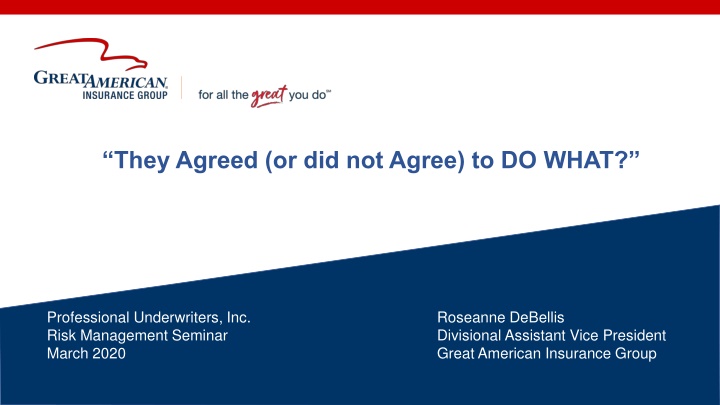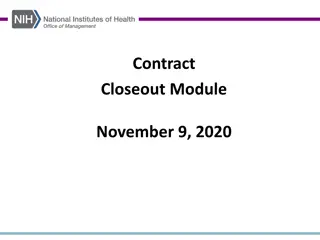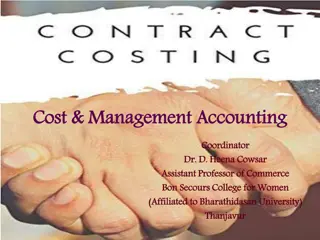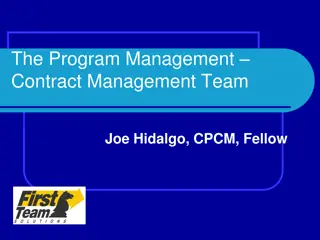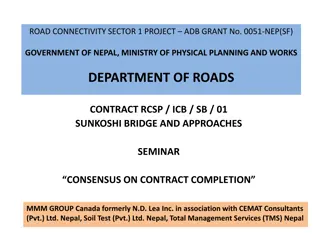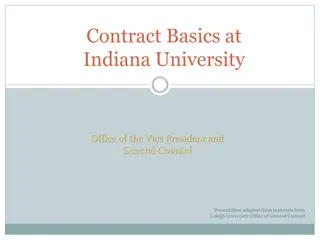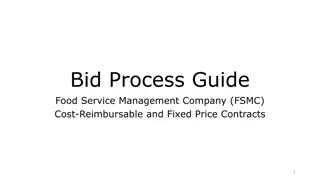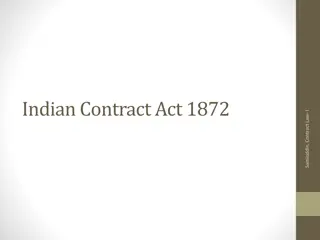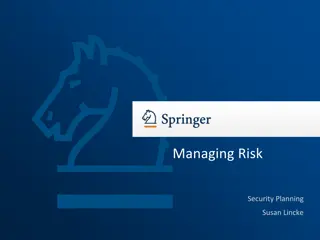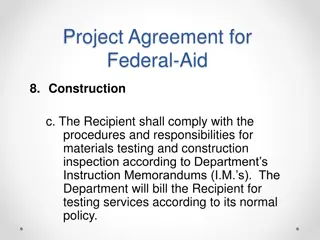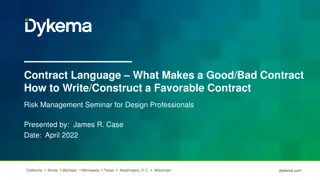Key Contract Provisions for Risk Management Seminar
Learn about key contract provisions for risk management seminars, including standards of care, indemnification, duty to defend, limit of liability, and more. Explore real claim studies and understand the importance of protecting yourself in contracts. Get insights into best practices and lessons learned in the industry.
Download Presentation

Please find below an Image/Link to download the presentation.
The content on the website is provided AS IS for your information and personal use only. It may not be sold, licensed, or shared on other websites without obtaining consent from the author.If you encounter any issues during the download, it is possible that the publisher has removed the file from their server.
You are allowed to download the files provided on this website for personal or commercial use, subject to the condition that they are used lawfully. All files are the property of their respective owners.
The content on the website is provided AS IS for your information and personal use only. It may not be sold, licensed, or shared on other websites without obtaining consent from the author.
E N D
Presentation Transcript
They Agreed (or did not Agree) to DO WHAT? Professional Underwriters, Inc. Risk Management Seminar March 2020 Roseanne DeBellis Divisional Assistant Vice President Great American Insurance Group
Introduction Why is your contract important? Key Contract Provisions Claims Studies How can you protect yourself? 2
Key Contract Provisions Standard of Care Indemnification and Duty to Defend Limit of Liability Scope of Services Code Compliance
Standard of Care: I Want the BEST in the Business The services the Architect provides will be performed in a manner consistent with heightened world-class standard of care. Architect warrants that the project and design services will be free from defects and are the best in class.
Claim Study: I Want the BEST in the Business Project: Upscale loft renovation Discipline: Architect Details of Claim: Architect provided design for renovation and guaranteed to the Client that the project cost would be within Client s budget. Cost overruns occurred due to a variety of factors, including overly-optimistic schedules, unreasonable client expectations, inexperienced contractor and weather related issues. Damages: $2million Lesson Learned: Perfection is impossible to attain.
Standard of Care: It Only Needs to be Reasonable The services the Architect provides will be performed in a manner consistent with that degree of care as ordinarily exercised by similarly situated engineers currently practicing under similar circumstances. No warranty or guarantee is included or intended in this Agreement or instruments of its services.
Indemnification and Duty to Defend: Defend Me, Even If I Am At Fault The Consultant hereby assumes entire responsibility for any and all damage or injury of any nature to property caused by or resulting from the execution of the work and agrees to defend and indemnify Owner from and against all claims, liabilities, damages, incurred by or imposed upon the Owner for damage or injury to such property, however such damage or injury may be caused directly or indirectly by (i) negligence of the Consultant, (ii) the negligence of the Owner and/or (iii) any other matter. Consultant shall retain an attorney of the Owner s choosing.
Claim Study: Defend Me, Even If I Am At Fault Project: Apartment Discipline: Land Surveyor Claim Details: Land Surveyor provided layout of a new building, 10-story, 90 residential units, which adjoins the Plaintiff s property. The Plaintiff commenced suit against Owner/Developer alleging construction debris and equipment encroached on Plaintiff s property, and that the erection of the new building caused cracking in the adjoining property s foundation and exterior walls. Owner/Developer sent tender letter to Land Surveyor demanding defense and indemnification per the terms of the contract. Claimed damages: $1million Lesson Learned: Review your indemnification agreement and ensure (1) no defense obligation exists and (2) indemnification obligation is negligence-based solely on design professional s negligence.
No Defense Obligation: Indemnification that is Negligence-Based Only To the fullest extent permitted by law, the Consultant shall indemnify and hold harmless Client from and against damages, losses, costs and expenses (including reasonable attorneys' and experts' fees, interest and court costs) to the extent such damages result from the negligent act, error or omission of the Consultant, its employees, subconsultants or anyone for whose actions the Consultant is legally responsible.
Limitation of Liability There s no limit to your liability The insurance requirements set forth herein shall in no way limit the Architect s liability arising out of work performed under the Agreement or related activities. The inclusions, coverage and limits set forth herein are minimum inclusions, coverages and limits.
Claim Study: Theres no limit to your liability Project: Assisted living project Discipline: Architect Details of Claim: Various design and construction defects which led to lawsuit against contractor and design professionals for various issues including water intrusion and roof issues. The Architect only had a $500,000 professional liability policy. The contractor was out of business and the engineer had no insurance coverage. Damages: $5 million Lesson Learned: Your limit of liability provision should be tied to your available insurance proceeds.
You Can and SHOULD Limit Your Liability Notwithstanding any other provision of this agreement and to the fullest extent permitted by law, the Owner agrees that the total liability, in the aggregate, of the Architect and the Architect s officers, directors, partners, employees, agents, and consultants, to the Owner, its subsidiary and/or affiliated companies and their respective officers, directors, employees, agents and anyone claiming by, through, or under the Owner for any and all injuries, claims, losses, expenses, damages whatsoever arising out of, resulting from or in any way relating to the Architect s services, this Agreement or any Addenda, from any cause or causes, shall be limited to the proceeds of the Architect s available insurance coverage or the total amount of compensation received by the Architect, whichever is greater.
.EVEN BETTER Notwithstanding any other provision of this agreement and to the fullest extent permitted by law, the Owner agrees that the total liability, in the aggregate, of the Architect and the Architect s officers, directors, partners, employees, agents, and consultants, to the Owner, its subsidiary and/or affiliated companies and their respective officers, directors, employees, agents and anyone claiming by, through, or under the Owner for any and all injuries, claims, losses, expenses, damages whatsoever arising out of, resulting from or in any way relating to the Architect s services, this Agreement or any Addenda, from any cause or causes, shall be limited to $250,000 or the total amount of compensation received by the Architect, whichever is greater. If your firm implements a limitation of liability clause of $250,000 or less in your contract, your firm may qualify for up to 15% reduction in premium with Great American Insurance Group.
Limitation of Liability: Things to Consider Negotiate Limitation of Liability Clause Reasonable relationship between cost of services and limiting damages Overreaching Public Policy
Claim Study: Dont let that scope creep! Project: Residential Discipline: Civil Engineer Details of Claim: Residential construction was 60% complete when a landslide occurred, resulting in significant damage. While the Insured s contract explicitly excluded design services for the retaining wall, the Insured did opine on certain aspects of the retaining wall design while they were at the Project. Damages: $7 Million Lesson Learned: Only provide the services for which you are contracted.
Claim Study: Dont let that scope creep! Project: Design/construction of a warehouse Discipline: Lighting design Details of Claim: Bodily injury accident resulting from a trip and fall sustained by the Plaintiff resulting in spinal cord and neck injuries. It was alleged that the exterior lighting design failed to provide sufficient lighting in hazardous areas. Insured s scope of services changed and another entity ultimately designed the exterior lighting. This change was never documented. Damages: $5million Lesson Learned: Document Document Document!
Compliance with All Laws: You re the Expert! (Aren t You?) 2.1.5 All professional design services and associated products or instruments of those services provided by the Project Consultant shall: .1 Be in accordance with all applicable codes, laws, and regulations of any governmental entity, including, but not limited to with the Owner serving as the interpreter of the intent and meaning of any applicable code [.] School Board of Broward County v. Pierce Goodwin Alexander & Linville, 2014 WL 1031461 (Fla.4th DCA 2014)
Claim Study: Youre the Expert! (Arent You?) Project: School Discipline: Architect Details of Claim: Renovation of a high school in Florida wherein the architect s design was ultimately held to be not code compliant regarding fire safety issues. This resulted in increased construction costs. Damages: Due to the language in the Architect s contract regarding compliance with all applicable codes , the Court held that the Architect agreed to a heightened standard of care and was thus in breach of contract. Lesson Learned: Again, the standard is reasonableness School Board of Broward County v. Pierce Goodwin Alexander & Linville, 2014 WL 1031461 (Fla.4th DCA 2014)
Problems with Compliance ALL with Laws Many laws have contradictory provisions Not within a design professional s expertise Regulations and laws could change during the course of construction Heightened standard of care
Compliance with Laws: You Don t Need to be the Expert Architect shall exercise usual and customary professional care in its efforts to comply with codes, regulations, laws, rules, ordinances, and such other requirements in effect as of the date of the execution of this Agreement.
Summary: How to protect yourself Know what your contract says Get that contract reviewed: ask your PUI Agent or Insurance Carrier Make sure the contract is signed by your client Document your file Keep the standards reasonable
Questions? Comments? Roseanne DeBellis Divisional Assistant Vice President rdebellis@gaig.com 347.266.0803
